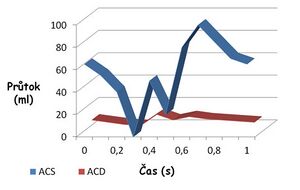Coronary blood flow
From WikiLectures
Anatomical introduction[edit | edit source]
- two coronary arteries that supply heart muscle retreat from the sinuses behind the aortic valve
- capillarization of the heart muscle is very dense, so the ratio of capillaries to muscle fibers is approximately 1:1
- blood flow is higher in the right coronary artery in 50% of people, in the left coronary artery in 20% of people, the same flow in both arteries in 30% of people
- most of the venous blood returns to the heart through the coronary sinus and the anterior heart veins that flow into the right atrium + in addition, some vessels flow directly into the heart chambers
Coronary blood flow[edit | edit source]
- about 5% of the minute cardiac output (250 ml/min at rest and 600 ml/min at exercise) flow through the coronary artery, about 85% of this volume through the left and 15% through right coronary arteries
- coronary flow can be measured by inserting a catheter into the coronary sinus and using the Kety method
- A number of methods using radionuclides (for example thallium) can be used to study the distribution of blood flow in individual areas of the heart and to identify ischemic areas and infarct foci
Coronary flow changes[edit | edit source]
- at rest, the heart extracts 70-80% oxygen from the blood that flows through it
- oxygen consumption can be significantly increased only by increasing the flow, which increases whenever myocardial metabolism increases
- coronary artery lumen and consequently blood flow are affected not only by pressure changes in the aorta but also by chemical and neural factors
Chemical factors[edit | edit source]
- increased local concentration of CO2, H+, K+, lactate, prostaglandin, adenine nucleotide, and adenosine leads to vasodilation
- asphyxia, hypoxia, and intracoronary cyanide injections increase the flow by 200-300% (a common feature of these stimuli is cardiac fiber hypoxia), a similar increase in flow was found after opening the occluded coronary artery
Neural factors[edit | edit source]
- coronary arterioles contain α-adrenergic receptors that mediate vasoconstriction and β-adrenergic receptors acting on vasodilation
- noradrenergic fibers cause vasoconstriction and vasodilation (vasodilation is the result of the formation of vasodilatory metabolites in the myocardium after increasing its activity)
- if the inotropic and chronotropic effects of adrenergic fibers are blocked by β blockers, noradrenergic nerve stimulations cause vasoconstriction in awake animals (the direct effect of noradrenergic stimulation is constriction)
- vagus nerve causes vasodilation
Links[edit | edit source]
Literature[edit | edit source]
- GANONG, William F. Přehled lékařské fyziologie. 20. edition. Praha : Galén, 2005. pp. 890. ISBN 80-7262-311-7.
- TROJAN, Stanislav. Lékařská fyziologie. 4. edition. Praha : Grada, 2003. pp. 772. ISBN 80-247-0512-5.

